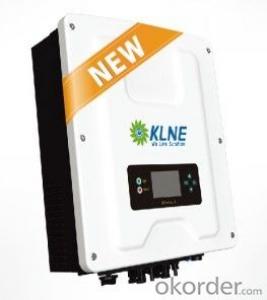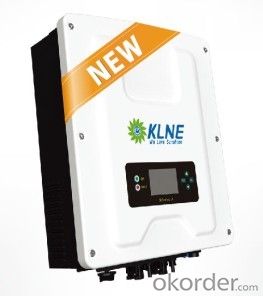Energizer Solar Inverter Solartec D 2500 with 2 MPPT WiFi
- Loading Port:
- Shanghai
- Payment Terms:
- TT OR LC
- Min Order Qty:
- -
- Supply Capability:
- 10000 set/month
OKorder Service Pledge
Quality Product, Order Online Tracking, Timely Delivery
OKorder Financial Service
Credit Rating, Credit Services, Credit Purchasing
You Might Also Like
Solartec D 2500,3000,3600,4000,4600,5000
2MPPT Trackers
online monitoring system by integrated WIFI
Integrated DC Switch
Comprehensive protection functions
Graphic display
High efficiency 97.5%
RS 485/RS 232/SolarLog Communication
5 Years warranty
G83,G59,VDE 4105,VDE 0126,CEI
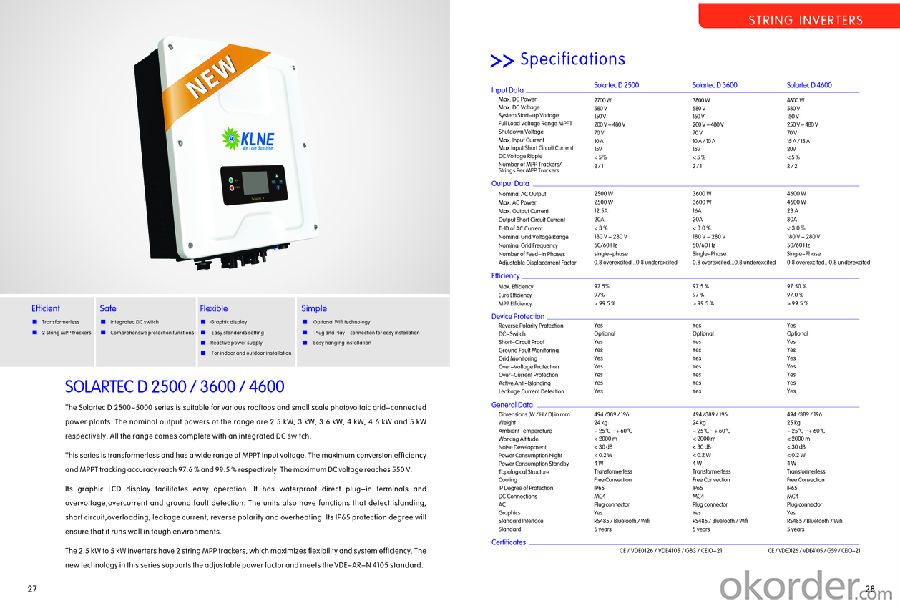
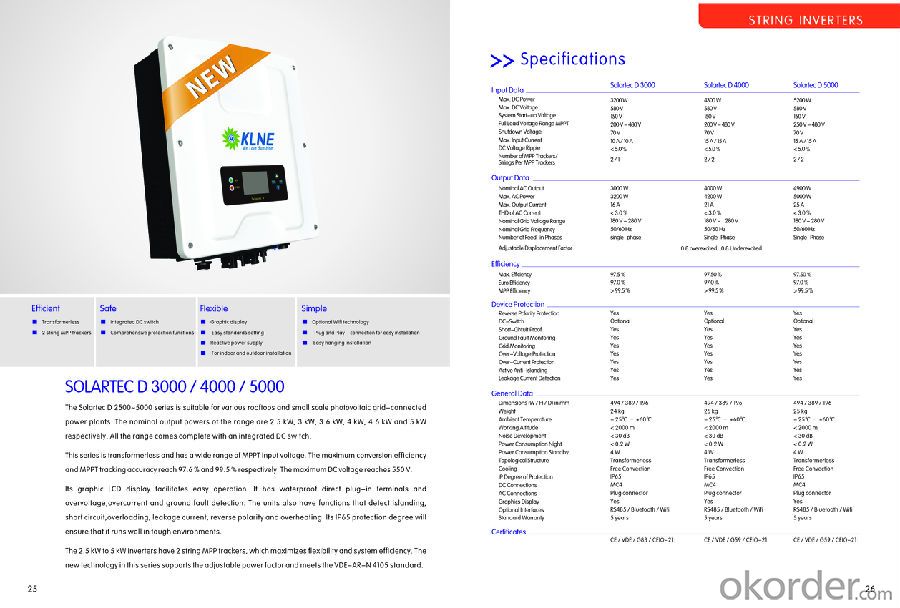
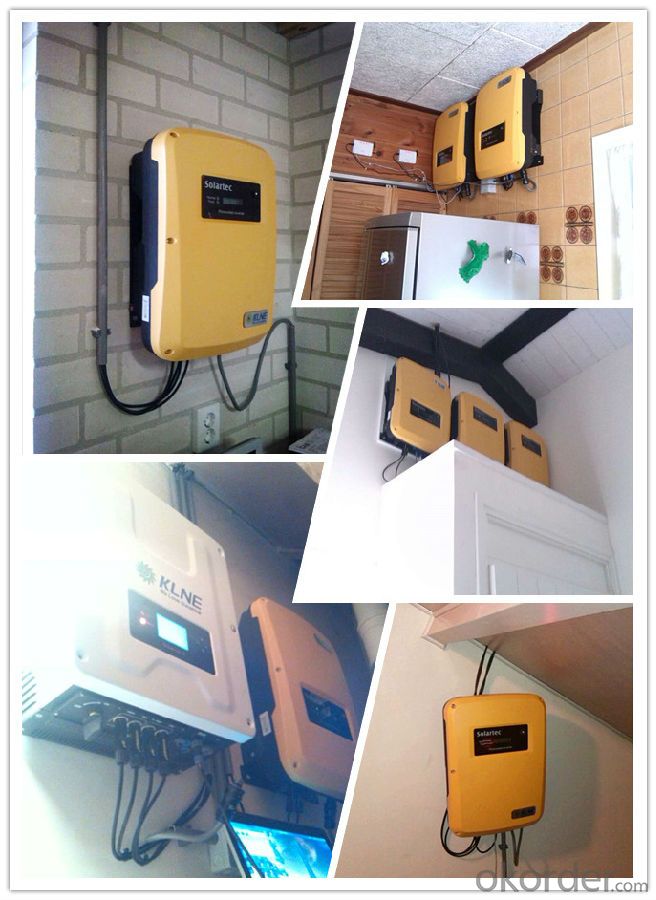
- Q: How does a solar inverter communicate with other components of a solar power system?
- A solar inverter communicates with other components of a solar power system through various communication protocols such as wired interfaces like RS485 or Ethernet, and wireless technologies like Wi-Fi or Zigbee. These communication channels enable the inverter to exchange data and information with other components such as solar panels, batteries, and monitoring systems. This communication allows for real-time monitoring, control, and coordination of the system, optimizing its performance and ensuring efficient energy production and management.
- Q: Can a solar inverter be used with a solar-powered street lighting system?
- Yes, a solar inverter can be used with a solar-powered street lighting system. A solar inverter is responsible for converting the DC power generated by solar panels into AC power, which is necessary for powering street lights. By integrating a solar inverter, the solar-powered street lighting system can efficiently convert and utilize the energy generated by the solar panels, ensuring the proper functioning of the lights.
- Q: Can a solar inverter be used in commercial or industrial applications?
- Yes, a solar inverter can be used in commercial or industrial applications. Solar inverters are designed to convert the direct current (DC) generated by solar panels into alternating current (AC) suitable for use in commercial or industrial settings. They are commonly used to power various electrical loads, machinery, and equipment in these sectors, helping to reduce energy costs and promote sustainability.
- Q: What are the potential risks of overheating a solar inverter?
- The potential risks of overheating a solar inverter include reduced efficiency, decreased lifespan, and potential damage to the internal components. It can also lead to unexpected shutdowns or malfunctions, resulting in a decrease in solar energy production. Additionally, overheating can pose a fire hazard, especially if proper cooling mechanisms or ventilation are not in place. Regular monitoring and maintenance are crucial to prevent these risks and ensure optimal performance of the solar inverter.
- Q: What is the role of a grid protection relay in a solar inverter?
- The role of a grid protection relay in a solar inverter is to monitor the electrical grid for any abnormalities or faults, and to disconnect the solar inverter from the grid if necessary. This helps to ensure the safety and stability of the grid, as well as protecting the solar inverter from potential damage.
- Q: Can a solar inverter be used in systems with different module strings?
- Yes, a solar inverter can be used in systems with different module strings. Solar inverters are designed to be compatible with a wide range of module string configurations, allowing for flexibility in system design and installation. The inverter's maximum input voltage and power ratings should be considered to ensure compatibility with the different module strings, but as long as these specifications are within the inverter's limits, it can effectively convert the DC power generated by the module strings into AC power for use in the system.
- Q: What is the role of MPPT (Maximum Power Point Tracking) in a solar inverter?
- The role of MPPT (Maximum Power Point Tracking) in a solar inverter is to optimize the efficiency of the solar panel system by continuously adjusting the voltage and current to ensure that the panel operates at its maximum power point. This helps to extract the maximum available power from the solar panels under varying environmental conditions, such as changes in sunlight intensity or temperature. By dynamically tracking the optimal operating point, MPPT maximizes the energy output of the solar panels and improves the overall performance of the solar inverter system.
- Q: What is the role of a solar inverter in a solar-powered remote monitoring system?
- The role of a solar inverter in a solar-powered remote monitoring system is to convert the direct current (DC) electricity generated by the solar panels into alternating current (AC) electricity that can be used to power the monitoring system. It also ensures that the electricity generated matches the requirements of the monitoring equipment, regulates the voltage, and assists in efficient power transmission and distribution.
- Q: How does a solar inverter handle voltage and frequency regulation?
- A solar inverter handles voltage and frequency regulation by converting the direct current (DC) generated by solar panels into alternating current (AC) that matches the voltage and frequency of the electrical grid. It does this by using advanced power electronics and control systems to monitor and adjust the output voltage and frequency to meet the required standards. This ensures that the electricity generated by the solar panels is compatible with the grid and can be seamlessly integrated into the existing power supply.
- Q: Can a solar inverter be used with a hybrid solar system?
- Yes, a solar inverter can be used with a hybrid solar system. A hybrid solar system combines solar power with other power sources, such as batteries or a backup generator. The solar inverter converts the direct current (DC) electricity generated by the solar panels into alternating current (AC) electricity, which can be used to power appliances and devices. Whether it is a grid-tied, off-grid, or hybrid solar system, a solar inverter is an essential component for converting and utilizing the solar energy effectively.
Send your message to us
Energizer Solar Inverter Solartec D 2500 with 2 MPPT WiFi
- Loading Port:
- Shanghai
- Payment Terms:
- TT OR LC
- Min Order Qty:
- -
- Supply Capability:
- 10000 set/month
OKorder Service Pledge
Quality Product, Order Online Tracking, Timely Delivery
OKorder Financial Service
Credit Rating, Credit Services, Credit Purchasing
Similar products
Hot products
Hot Searches
Related keywords
